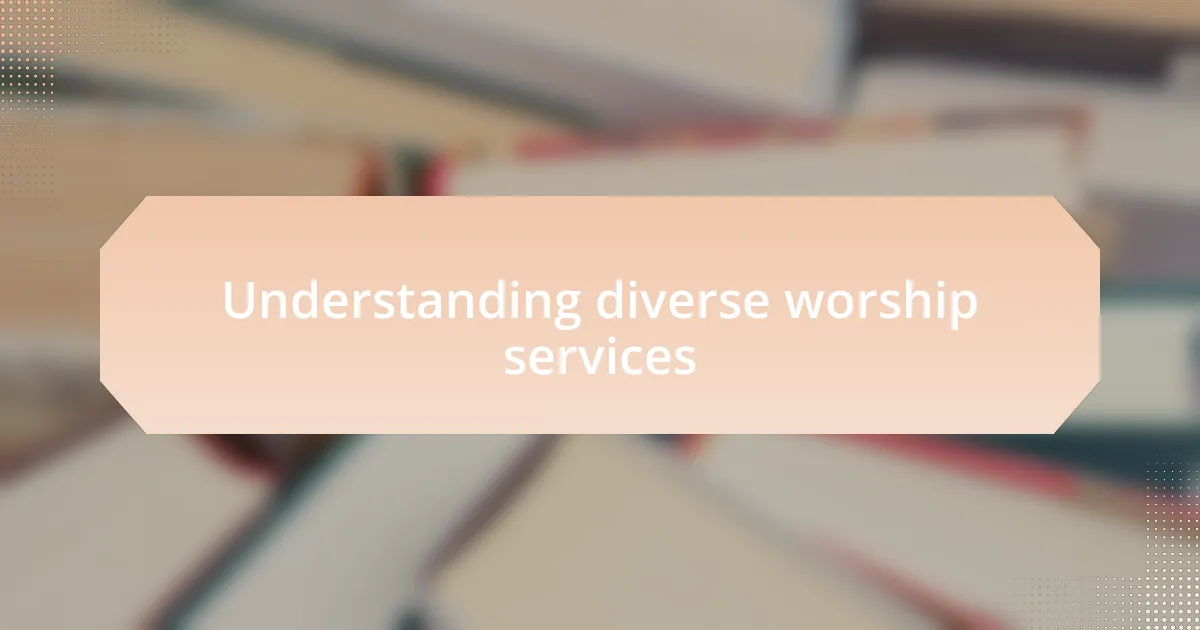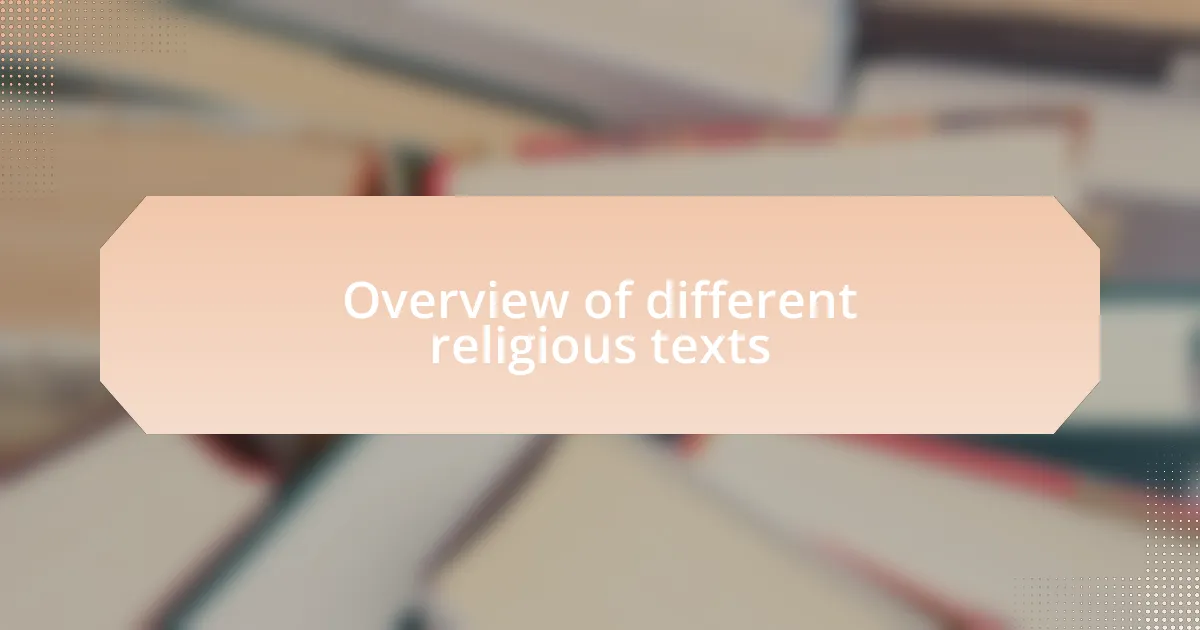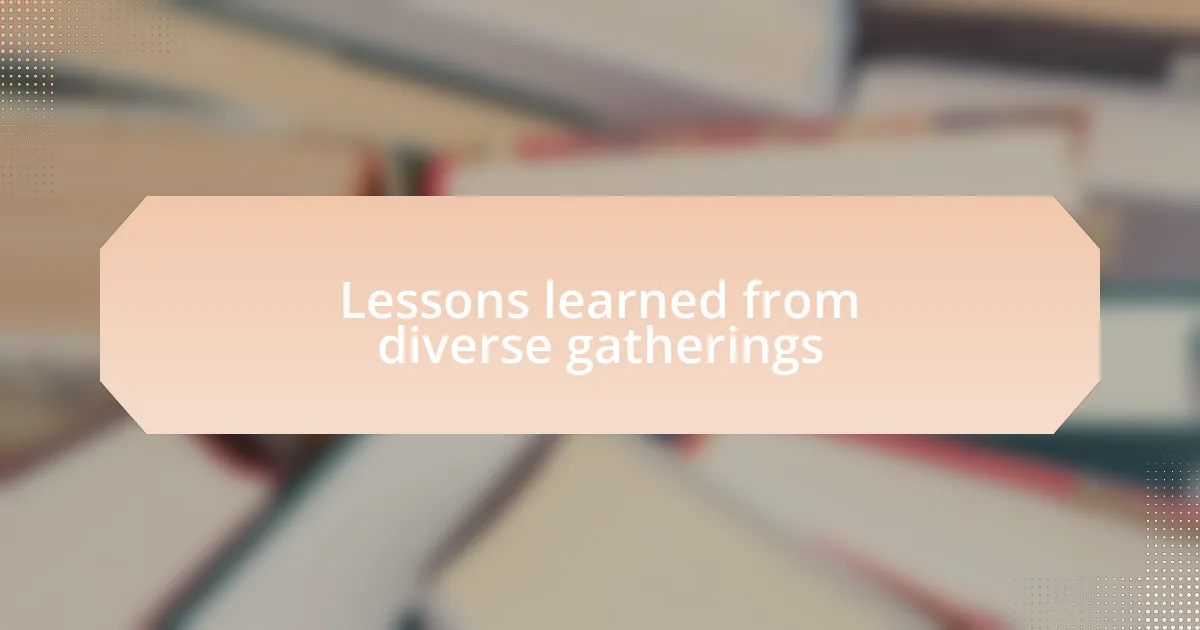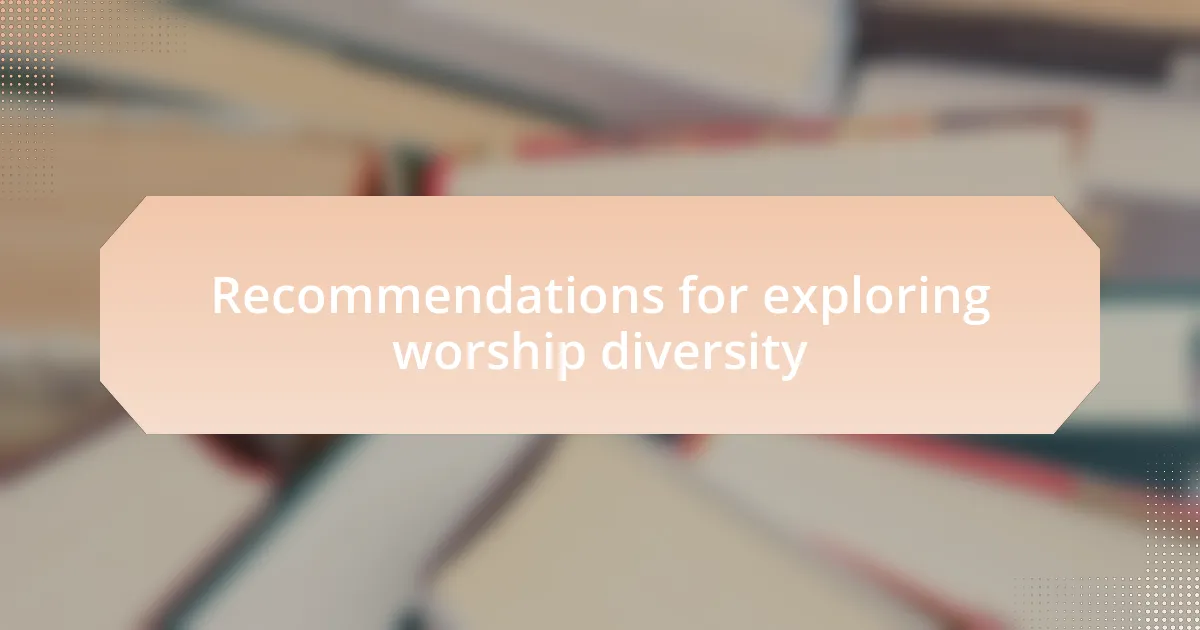Key takeaways:
- Diverse worship services reflect unique cultural backgrounds, emphasizing the connection between spirituality and community identity.
- Experiencing religious diversity fosters empathy, respect, and deeper understanding of various belief systems.
- Religious texts, such as the Bhagavad Gita and Quran, provide profound insights into faith and cultural history, shaping spiritual identities.
- Participating in different worship gatherings emphasizes the importance of inclusivity, communal celebration, and personal reflection in spirituality.

Understanding diverse worship services
Diverse worship services encompass a wide range of traditions, beliefs, and practices, each reflecting the unique cultural backgrounds of their communities. I remember attending a Kwanzaa celebration at a local African American church, where the emphasis on community and heritage struck me profoundly. How could I have guessed that spiritual practices could so vividly intertwine with cultural identity?
One significant aspect of understanding these services is recognizing the different ways people connect with the divine. In a Quaker meeting I once attended, the silence felt deafening yet comforting, allowing personal reflection in a communal space. Have you ever experienced that powerful stillness, where thoughts and prayers seem to mingle in the air around you?
Moreover, the emotional expressions during worship can vary greatly, shaping our engagement with spirituality. I’ve seen people shed tears during a gospel performance, moved by the music’s soul-stirring ability to uplift. It makes me wonder, how does music play such a pivotal role in our collective worship experiences, transcending language and cultural boundaries?

Importance of religious diversity
Experiencing religious diversity is crucial for broadening our understanding of the world and ourselves. I recall attending a Hindu Diwali celebration, where the vibrant colors and rituals created a rich tapestry of meaning that was entirely new to me. This experience pushed me to question my own beliefs and appreciate the beauty in others’ traditions—have you ever found that stepping into someone else’s spiritual realm can reflect back on your own journey?
Engaging with different faiths fosters empathy and respect, which are essential in our increasingly interconnected society. When I participated in a Buddhist meditation session, surrounded by individuals each with their own stories, I was struck by the shared human experience of seeking peace. It’s fascinating to consider, how can understanding different belief systems cultivate a more inclusive and compassionate world?
Moreover, religious diversity encourages dialogue, sparking conversations that challenge preconceived notions and deepen our insights. I once found myself in a discussion with friends from various faith backgrounds, exploring our similar values amidst differing practices. It made me ponder, could these diverse viewpoints actually lead to a richer, more nuanced understanding of spirituality for all of us?

Overview of different religious texts
Religious texts serve as the cornerstones of belief systems, providing guidance, inspiration, and a sense of community for their adherents. For instance, when I first picked up the Bhagavad Gita, I was immediately taken by its profound philosophical dialogue. It struck me that these writings do more than convey teachings; they encapsulate a culture’s history, struggles, and aspirations. Have you ever felt the weight of words that have transcended time and space?
The Quran is another example that profoundly impacted my understanding of faith and devotion. During a visit to a mosque, I listened to an Imam recite verses that imbued the space with reverence and tranquility. The poetic nature of these texts resonated with me, highlighting how language can elevate spiritual experience. This brings to mind an important question: how do these sacred words shape the identities of those who embrace them?
Of course, it’s not just the texts themselves but the myriad interpretations and practices they inspire that make exploring religious literature so compelling. I remember hearing a friend discuss the teachings of the Tao Te Ching and how they influenced her approach to everyday challenges. Reflecting on this, I wondered, could the essence of interconnectedness found in various traditions lead to a collective wisdom that enriches all our lives?

Key themes in religious literature
Key themes in religious literature often revolve around fundamental concepts such as morality, the nature of the divine, and humanity’s relationship with the universe. When I delved into the writings of various faiths, it became clear that despite cultural differences, there’s an underlying quest for understanding that transcends borders. Have you ever noticed how these texts echo universal truths that resonate within us all?
Another prominent theme is the idea of community and belonging, which is beautifully illustrated in the teachings of the New Testament. I remember attending a service where the pastor spoke about love and fellowship, inviting everyone to be part of something greater than themselves. It struck me how these narratives foster a sense of unity and purpose, reminding us that we are not alone on our spiritual journeys. What role do you think community plays in shaping our faith?
Additionally, the exploration of suffering and redemption frequently emerges in religious literature, offering comfort in times of distress. I recall reading the Book of Job and feeling a profound empathy for his trials. It made me reflect on my own struggles and how they can form a pathway to deeper insight and resilience. Does it not make you wonder how our shared experiences of hardship can ultimately lead us toward a more compassionate understanding of one another?

Personal experiences with worship services
Attending various worship services has been like stepping into different worlds, each one offering unique perspectives on spirituality. I remember the first time I entered a vibrant Hindu temple, the air thick with the scent of incense and the sound of chanting enveloping me. It felt like a beautiful celebration, igniting my curiosity about how diverse practices can enrich our understanding of the divine. Have you ever found yourself in a place where the energy of the service just takes your breath away?
One particular experience stands out: attending a small, intimate Quaker meeting. The silence felt profound, almost sacred. Instead of the usual hymns, we shared reflections in that quiet space, connecting with one another through shared thoughts and feelings. It was a remarkable contrast to the lively services I was used to, showing me that worship can be deeply personal and still foster community. Isn’t it intriguing how silence can sometimes speak louder than words?
During a lively youth service at a neighboring church, I witnessed the power of modern worship music. The energy was electric, and I could feel the passion radiating from the youth as they sang and danced. It reminded me of how music can bridge generations, inspiring joy and connection among worshippers. Have you felt that exhilarating rush of being part of something so spirited? Those moments truly highlight how worship can adapt and evolve while still maintaining a sense of reverence and purpose.

Lessons learned from diverse gatherings
Experiencing different worship gatherings has taught me that the essence of spirituality often transcends formal traditions. I remember attending a traditional African American church service where the communal singing and spirited preaching created an atmosphere of almost palpable joy. That day, I couldn’t help but reflect on how communal celebration nurtures spiritual connection and makes faith feel alive. Have you ever felt such a strong sense of belonging from simply sharing a moment with others?
Each gathering has also imparted the lesson that inclusivity enriches our spiritual journeys. At an interfaith service, I was deeply moved by the diverse expressions of faith, from prayers to readings. It struck me how, despite different beliefs, we were united in our quest for meaning and understanding. I left that day with a profound respect for the myriad ways people seek the divine. Isn’t it fascinating how these shared moments can foster respect and empathy across differing beliefs?
Moreover, reflecting on the quieter, contemplative services, like a Buddhist meditation session I attended, revealed another layer of spiritual learning—the importance of mindfulness. Participating in that peaceful stillness taught me that worship isn’t solely about grand expressions; it can also be about introspection and personal growth. In our fast-paced lives, where do we find time for such reflection? I believe that cultivating silence and awareness can deepen our spiritual insights far more than we might initially realize.

Recommendations for exploring worship diversity
To truly explore worship diversity, I recommend stepping outside of your comfort zone. One of my most memorable experiences was attending a Quaker meeting, where silence reigned for long stretches. The stillness allowed a deep connection with both the divine and fellow attendees, echoing the idea that sometimes silence speaks louder than words. Have you ever thought about how powerful it can be to share a space without the need for constant dialogue?
Another practical step is to participate in cultural festivals or events tied to different faith traditions. I once volunteered at a Diwali celebration, which opened my eyes to the beauty of shared rituals and community bonding. The atmosphere was vibrant and welcoming, filled with lights, colors, and shared stories. Such events certainly highlight how personal expressions of faith can create communal joy, making you wonder—what have you learned from the celebrations of others?
Lastly, consider inviting friends from diverse backgrounds to accompany you to various religious services. When I attended a Native American prayer circle with a close friend, their insights enriched my understanding and appreciation of the tradition. Sharing these experiences fosters dialogue and deepens connections. How often do we get the chance to explore spiritual practices through the eyes of others?